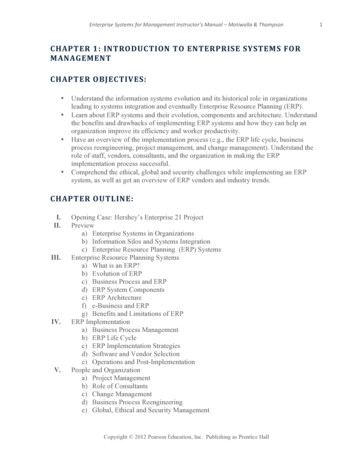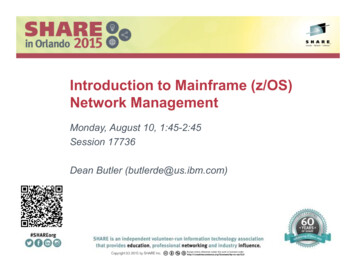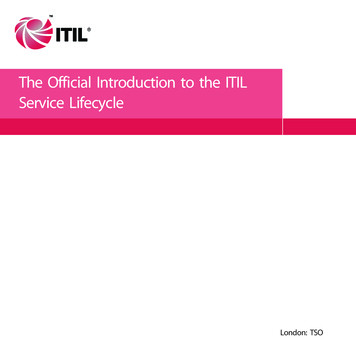
Transcription
Introduction1Current & Future Use of Telemedicine3Current Opinions5Top 5 Barriers7Reimbursement8Technology Costs/Maintenance10Physician Resistance11Sourcing Qualified Providers/Physician Shortage12Licensing13Benefits14Improving Patient Access and Care Deliverability15Cost Savings16Improving Quality17Meeting Patient Demand18Incorporating TelemedicineAbout LocumTenens.com1921iLocumTenens.com 2655 Northwinds Parkway Alpharetta, GA 30009 800.562.8667
IntroductionHealthcare technology is rapidly advancing and expanding due to more insured patients seeking accessto healthcare providers, a shortage of physicians, andan aging and unhealthier population. Telemedicine isone of the fastest growing sectors of healthcare aimingto solve the problems arising with growing demand.Telemedicine provides medical services to patients remotely through electronic devices, typically involv ingreal-time communication between two sites. A reportfrom BCC Research shows the global telemedicinemarket reached 19.2 billion in 2014 and is expectedto increase to 43.4 billion by 2019. According to theAmerican Telemedicine Association (ATA), more thanhalf of all hospitals in the United States use some kindof telemedicine service.Originally used to provide better access to care forrural patients, telemedicine has spread to serve veterans, mentally ill, elderly, poor and even incarceratedpatients. All kinds of healthcare delivery systems nowincorporate telemedicine into their delivery strategy,including hospitals, private practice and home healthagencies. There are many electronic services providedthrough telemedicine; physicians can treat patientsthrough online video transmittal, primary care physicians can consult with specialists, radiologists canread diagnostic images and medical professionals canmonitor vital signs of patients.1LocumTenens.com 2655 Northwinds Parkway Alpharetta, GA 30009 800.562.8667
LocumTenens.com surveyed clients about telemedicine, including the benefits and barriers, and askedabout their current or future use of telemedicine aspart of their healthcare strategy. The majority of surveyrespondents were from clinics or community healthcenters, group/office based practice systems and hospitals.Which of the following best describes your tpoura ceanHoagitspe0%alnmetComnpayheOtr2LocumTenens.com 2655 Northwinds Parkway Alpharetta, GA 30009 800.562.8667
Current andFuture Use ofTelemedicineAccording to the LocumTenens.com survey, a littlemore than half of respondents currently utilize telemedicine services, slightly more than a quarterof them plan to use it at some point in the future,and most of those considering it see themselves utilizing it within the next year.The most common types of service offered by surveyrespondents, including those from hospitals, consist of psychiatry, radiology, neurology and cardiology; about 50 other specialties were also selected orwritten-in as telemedicine services currently offeredby survey respondents. These are on the next page.Which of the following best describes your organization?Does your facility currentlyutilize telemedicine services?Does your facility plan to utilize telemedicineservices at some point in the future?When does your facility plan onutilizing telemedicine services?Don’t KnowDon’t Know3–5 YearsDon’t KnowYesLess than1 YearYesNoNo1–2 Years3LocumTenens.com 2655 Northwinds Parkway Alpharetta, GA 30009 800.562.8667
We asked healthcare facility administrators about theircurrent or future use of telemedicine services andasked them to select all areas that apply. Seventy-onepercent selected the use of telemedicine for patientconsults, 40 percent said for patient monitoring, 36percent said they chose it to supplement existing staffand 21 percent used it for call coverage.How do you utilize or plan to utilize telemedicine services?(Select all that apply.)100%80%71Telepsychiatry is the most common form of telemedicine currently utilized by survey respondents, with 42percent using it for adult psychiatry and 21 percentfor child and adolescent psychiatry. Another popular response was teleradiology with 31 percent.Teleneurology was selected by 21 percent of respondents and 16 percent use it for cardiology. The surveydirected recipients to select all specialties which applied.60%40%403620%210%Call CovgeratiPaeentCounsPaltsntietMSuPsychiatry (Adult)pponritolemingtenExistintagSff42%Emergency ly Practice8%Psychiatry (Child & Adolescent)21%Internal Medicine8%Surgery – General5%Surgery – Pediatric2%Podiatry3%Surgery – PlasticNeurology21%Endocrinology2%6%Physical Medicine & Rehabilitation3%Surgery – OrthopedicCardiology16%2%Advanced Practice Professionals6%Pathology3%OphthalmologyOther stetrics/Gynecology2%Pulmonary medicine10%Hematology5%Surgery – Neurosurgery3%Surgery – other2%Dermatology10%Nephrology5%Infectious Diseases3%Radiation Oncology2%Oncology8%Gastroenterology5%Allergy & ology3%4LocumTenens.com 2655 Northwinds Parkway Alpharetta, GA 30009 800.562.8667
CurrentOpinionsAlmost half of respondentssee the broad application oftelemedicine as a key differentiator for their organizationover the next several years.Thirty percent are currentlyreviewing the opportunity touse telemedicine as a newor additional method of caredeliverability.Twenty-one percent are unsureor have no plans to utilize telemedicine at this time.5LocumTenens.com 2655 Northwinds Parkway Alpharetta, GA 30009 800.562.8667
We asked healthcare facility administratorsif they thought the use of telemedicine willincrease or decrease healthcare costs.Effect of Telemedicine onHealthcare CostsEffect of Telemedicineon QualityIncrease (54%)Decrease (53%)No Change (35%)No Change (31%)Increase (12%)Decrease (15%)Effect of Telemedicineon Delivery EfficienyIncrease (80%)Decrease (20%)6LocumTenens.com 2655 Northwinds Parkway Alpharetta, GA 30009 800.562.8667
Top 5 BarriersThere were five main concerns regarding telemedicinefor healthcare facility administrators, based on the survey results. There are many obstacles administratorsand practitioners must maneuver to provide successful telemedicine services, but due to rapidly increasingacknowledgment of the benefits of telehealth, legislative and educational barriers are falling.The biggest concern, according to the survey, is aboutreimbursement issues, with half of all respondentsworried or confused about being paid for telemedicineservices. Technology costs and maintenance wereconsidered a barrier by 37 percent, 29 percent find issues with physician resistance, 22 percent of respondents have problems with licensing issues and another22 percent have difficulty sourcing qualified providers.If any, what barriers prevent you from using or expandingtelemedicine services? (Select all that nens.com 2655 Northwinds Parkway Alpharetta, GA 30009 800.562.8667
1ReimbursementThere is a lot of confusion about which states providetelemedicine reimbursement through Medicaid, whichstates require private insurers to offer reimbursementand which types of services can be reimbursed. Currently, the federal Medicaid statute does not recognizetelemedicine as a distinct healthcare service, and itsservices are not reimbursed differently than face-toface encounters.December 31, 2000 are also considered for reimbursement, no matter where the originating site is located.Some facilities may easily fall under one designationbut not another, so CMS added a policy change in thefinal rule of the 2014 Medicare Physician Fee Schedule.This expands the coverage of telemedicine servicesable to be reimbursed by changing the way originatingsites are defined as “rural.”Initially, Medicare covered reimbursement for telemedicine in defined rural areas. The present reimbursement policy of the Centers for Medicare & Medicaid Services (CMS) covers originating sites that arelocated in areas that are labeled as rural health professional shortage areas (HPSAs) or sites not in metropolitan statistical areas (MSAs). Entities participatingin federal telemedicine demonstration projects as ofThe Telehealth Enhancement Act of 2014 (S.2662) is abill proposed in Washington seeking to expand telemedicine coverage for Medicare beneficiaries andpatients in remote locations. Its companion bill, theMedicare Telehealth Parity Act of 2014 (HR.3306), hasalso been proposed. This bill would expand the reimbursement policies for managing chronic diseases andillnesses.8LocumTenens.com 2655 Northwinds Parkway Alpharetta, GA 30009 800.562.8667
Each state governs its own telemedicine coverage andif or how providers will be reimbursed. Most stateshave some form of Medicare reimbursement for telemedicine programs, and more and more states are requiring private insurers to cover telemedicine servicesas well.Medicaid and Private Insurance Coverage for TelehealthMedicaid Coverage for TelehealthPrivate Insurance Coverage for TelehealthNo Required Coverage for Telehealth/No Data9Source: Center for Connected Healthy Policy (Map current as of March 2015)LocumTenens.com 2655 Northwinds Parkway Alpharetta, GA 30009 800.562.8667
2 Technology Costs/MaintenanceConsidering telemedicine technology, and the potential costs, can be daunting. What is the cost ofpurchasing new software or hardware and what feesare involved in maintaining the equipment? Will the newprocess be difficult to use? Will physicians adapt to thenew technology?Fortunately, there can be minimal costs related totelemedicine services. The primary cost is often justthe purchase or installation of equipment, which varies based on specialties. Equipment can just consist ofa microphone and webcam, though some more advanced tools may be needed for certain services, likediagnostic or imaging devices. Be mindful that mosttelemedicine services do require service fees. However, there are many telemedicine companies that donot require any service fees, so the overall cost of in-stallation is minor when maintenance fees are not afinancial factor. Physicians can see more patients in aday and not have to worry about the costs of usingtelehealth services to treat the patients.How safe is the information transmitted between thetwo sites? Is it still HIPAA-compliant? Telemedicinetechnology must follow privacy rules and regulationswhen transmitting patient information through electronic means and remain HIPAA-compliant. Softwareshould have cryptographic mechanisms and access toelectronic medical records (EMR) should have the ability to be controlled by the client, though some telemedicine service providers may not offer these features. They should also require screening of individualswho will have access to sensitive information prior toreceiving access.10LocumTenens.com 2655 Northwinds Parkway Alpharetta, GA 30009 800.562.8667
3 Physician ResistancePart of the resistance some physicians give to participating in telemedicine programs is due to lack ofunderstanding in how the system works and how thetechnology works. Primarily, physicians are wary ofadapting to the new technological equipment theyneed in order to remotely treat patients. With bettereducation by hospital or administrative staff in training physicians and nurses on how to use the technology, a healthcare system may have more success inovercoming resistance. This also includes educationon more than just the technology and equipment.Doctors can be confused about reimbursement issues, where they can practice with their licenses, whatprescribing restrictions are in place and what rules andregulations they need to follow to comply with privacylaws. If telemedicine is incorporated into a health system’s strategy, providers should receive comprehensive informative sessions and undergo proper training,which should include an emphasis on the benefits tothem, the patients and the healthcare group to whichthey belong to ensure successful engagement.11LocumTenens.com 2655 Northwinds Parkway Alpharetta, GA 30009 800.562.8667
4Sourcing Qualified Providers/Physician ShortagePhysician shortage is a huge crisis facing the entire U.S.healthcare system. Many facility administrators considering telemedicine are concerned about how to findand incorporate qualified providers into their strategicplanning.With fewer physicians from which to choose, hospitals and healthcare organizations face a harder timerecruiting and worry about how much they need tospend on candidates or how long to search for them,especially with high physician turnover. According tothe 2013 Association of Staff Physician Recruiters InHouse Physician Recruitment Benchmarking Report,physician turnover has been steadily increasing overthe past three years, rising from 5.6 to 7.2 percent.Newly-insured patients through the Affordable CareAct will increase demand for primary care and specialist physicians. Fortunately, telemedicine offers some ofthe best solutions to the physician shortage. The primary care shortage in rural communities can be solvedby increasing the number of physicians available toremotely treat patients. Retention rates in these ruralareas may increase as doctors feel less isolated withthe ability to access more patients and even peersthrough telemedicine networks.There are also some questions for administratorsregarding the qualifications the doctors will needto possess to provide remote services. Each doctorneeds to be credentialed with the hospital and willneed licensing issues resolved. There also needs tobe agreements between health systems and management plans, especially when partnering between different organizations across state lines. Not only dophysicians need to receive extensive education andtraining in how to follow the rules and regulations ofincorporating telemedicine, but the healthcare organization needs training as well. The administrative staffneeds to understand how to negotiate contracts between hospitals, doctors and private and public insurance payers.12LocumTenens.com 2655 Northwinds Parkway Alpharetta, GA 30009 800.562.8667
5 LicensingRequirements for state licensing hinder somephysicians from treating patients located in statesoutside of the ones in which the physicians currentlyhold license to practice. Physicians can usually onlypractice medicine in any state in which they arelicensed, though there are currently some exceptions.In some cases, a physician may treat patients ina bordering state if he or she has an agreementor connection with a hospital or facility in thatneighboring state. Doctors serving patients in themilitary, VA physicians and public health serviceofficers only need to be licensed in one state toobtain the ability to practice in any state. Otherexceptions include medical or residential teachingor training, reacting to medical emergencies orconsultation between two medical personnel.To reduce the licensing barriers, some states opt touse alternative forms of licensing agreements acrossstates. The American Telemedicine Associationwebsite lists the following four models:1. Licensure by endorsement “is currently used bymost state boards to grant licenses to healthprofessionals licensed in other states that haveequivalent standards.”132. Mutual recognition “is a system in which thelicensing authorities voluntarily enter into anagreement to legally accept the policies andprocesses (licensure) of a licensee’s home state.”3. Reciprocity agreements “are between two or morestates in which each state gives the subjects of theother certain privileges, on the condition that itsown subjects shall enjoy similar privileges at thehands of the latter state.”4. Special purpose or limited licenses “allow healthprofessionals to have the option of obtaining alimited license for the delivery of specific healthservices under particular circumstances in additionto holding a full license in the state where theyprimarily practice.”Proponents of telemedicine are fighting to removethe licensing barriers currently in place. A proposalfor an interstate medical licensure compact wasproposed in Washington last year aiming to allowdoctors to practice medicine across state lines andreach more patients. Called the TELEmedicine forMEDicare (TELE-MED) Act (H.R. 3077), this bill wouldupdate the laws to reflect the advancements inhealthcare technology and allow qualified physiciansto have easier access to provide remote care.The Federation of State Medical Boards is workingon a proposal for an interstate medical licensurecompact, which should be ready for considerationin state legislation by 2015. The Interstate Compactfor Physician Licensure would facilitate the licensingprocess for physicians who want to practice inmultiple states, including for telemedicine services.LocumTenens.com 2655 Northwinds Parkway Alpharetta, GA 30009 800.562.8667
BenefitsUse of telemedicine has increased more in the lastdecade than it has since its inception decades ago. TheLocumTenens.com survey offered a list of potentialbenefits and asked recipients to choose any they haveseen or plan to see by using telemedicine services.The majority of respondents agreed telemedicine willimprove quality of patient care, will create a moretimely response to patient need and will provideadditional coverage and fill gaps. Other benefits thatmany recipients responded as seeing or expectingincluded increased patient satisfaction, access to newspecialties (and expanding patient access to specialists),cost savings and evaluation and management of acuteand chronic patients.If any, which of the following benefits have you seen or plan to see fromutilizing telemedicine services? (Select all that unteemaganmndssreddsaprageovll oknaoatialuEvLocumTenens.com 2655 Northwinds Parkway Alpharetta, GA 30009 800.562.8667
1Improving Patient Access &Care DeliverabilityOne of the clearest benefits of telemedicine is patientaccess to care in rural areas, which also includesthe ability to reach more than one doctor at a time.A primary care physician in a rural area can reach aspecialist in an urban location or even another stateto discuss a patient’s health and can consult with thepatient at the same time.This is particularly important in rural emergencydepartments, where there is often a lack of experiencedspecialists. The Mayo Clinic (mayoclinic.org) conducteda study on the success of its telestroke network,which places robots in rural emergency departmentsto connect with neurologists in other communityhospitals. The Mayo Clinic Telestroke Program hasimproved care deliverability and increased cost savingswith the “hub-and-spoke” network. “When comparinga rurally located patient receiving routine stroke careat a community hospital, a patient treated in thecontext of a telestroke network incurred 1,436 lowercosts and gained 0.02 quality-adjusted life-years overa lifetime.”state license for a physician to be allowed to practice inany VA facility in the country. Since its implementationof telemedicine with unrestricted licenses, the VA hashad tremendous su
Psychiatry (Child & Adolescent) 21% Internal Medicine 8% Podiatry 3% Surgery – Plastic 2% Neurology 21% Endocrinology 6% Physical Medicine & Rehabilitation 3% Surgery – Orthopedic 2% Cardiology 16% Advanced Practice Professionals 6% Pathology 3% Ophthalmology 2% Other specialty 15% Rheum











